
NGC 3184, the Little Pinwheel Galaxy, is a spiral galaxy approximately 40 million light-years away in the constellation Ursa Major. Its name comes from its resemblance to the Pinwheel Galaxy. It has two HII regions named NGC 3180 and NGC 3181.

NGC 520 is a pair of colliding spiral galaxies about 105 million light-years away in the constellation Pisces. They were discovered by astronomer William Herschel on 13 December 1784.

NGC 6744 is an intermediate spiral galaxy about 30 million light-years away in the constellation Pavo (Peacock). It is considered as a Milky Way mimic in the immediate vicinity, displaying flocculent (fluffy) arms and an elongated core. It also has at least one distorted companion galaxy superficially similar to one of the Magellanic Clouds. It was discovered from Parramatta in Australia by Scottish astronomer James Dunlop on 30 June 1826.

NGC 1232, also known as the Eye of God Galaxy is an intermediate spiral galaxy about 60 million light-years away in the constellation Eridanus. It was discovered by German-British astronomer William Herschel on 20 October 1784.

The Atlas of Peculiar Galaxies is a catalog of peculiar galaxies produced by Halton Arp in 1966. A total of 338 galaxies are presented in the atlas, which was originally published in 1966 by the California Institute of Technology. The primary goal of the catalog was to present photographs of examples of the different kinds of peculiar structures found among galaxies.

NGC 935 and IC 1801 are a pair of interacting galaxies within the constellation Aries. NGC 935 is the northern member of the pair and IC 1801 is the southern. NGC 935 and IC 1801 are the pair of galaxies. It's in the constellation Aries.

NGC 7 is a barred spiral galaxy located in the Sculptor constellation. It was discovered by English astronomer John Herschel in 1834, who was using an 18.7 inch reflector telescope at the time. Astronomer Steve Gottlieb described the galaxy as faint, albeit large, and edge-on from the perspective of the Milky Way; he also noted how the galaxy could only be observed clearly with peripheral vision, not by looking directly at it.
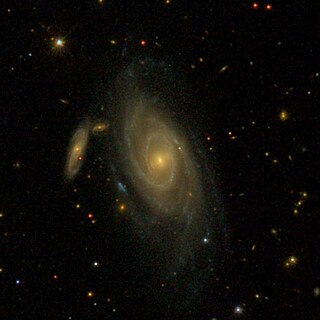
NGC 36 is a barred spiral galaxy in the constellation Pisces. It is located about 221 million light-years away. It was discovered in October 25, 1785, by the astronomer William Herschel.
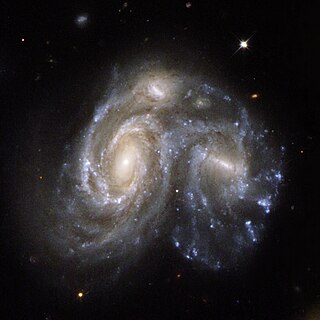
Arp 272 is a pair of interacting galaxies consisting of the two spiral galaxies NGC 6050 (left) and IC 1179 (right). Arp 272 lies around 450 million light years from Earth in the constellation of Hercules. The galaxies are part of the Hercules Cluster, which is itself part of the CfA2 Great Wall.

NGC 5566 is a barred spiral galaxy in the constellation Virgo, which is approximately 66 million light years away from Earth. The galaxy is the biggest in the constellation Virgo, stretching nearly 150,000 light years in diameter. The galaxy NGC 5566 was discovered on 30 April 1786 by the German-British astronomer William Herschel. It is included in Halton Arp's Atlas of Peculiar Galaxies. It is a member of the NGC 5566 Group of galaxies, itself one of the Virgo III Groups strung out to the east of the Virgo Supercluster of galaxies.

NGC 61 is a pair of lenticular galaxies, NGC 61-A and NGC 61-B in the constellation Cetus. Both were discovered on September 10, 1785, by William Herschel.

NGC 72 is a barred spiral galaxy estimated to be about 320 million light-years away in the constellation of Andromeda. It was discovered by R. J. Mitchell in 1855 and its magnitude is 13.5.
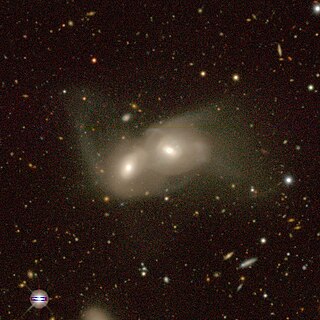
NGC 526 is a pair of interacting lenticular galaxies in the constellation of Sculptor. Both the constituents are classified as S0 lenticular galaxies. This pair was first discovered by John Herschel on September 1, 1834. Dreyer, the compiler of the catalogue described the galaxy as "faint, small, a little extended, the preceding of 2", the other object being NGC 527.

NGC 6293 is a globular cluster located in the constellation Ophiuchus. Its Shapley–Sawyer Concentration Class is IV. It was discovered by the American astronomer Lewis A. Swift on 8 July 1885. Like many other globular clusters, its distance is not well known; it may be anywhere from 31000 to 52000 light-years away from Earth.

NGC 116 is a possibly lost or "non-existent" object in the constellation Cetus. This object is up for debate and has been considered to possibly be PGC 1671. The NED entry for this object contains the note NGC identification is very uncertain.
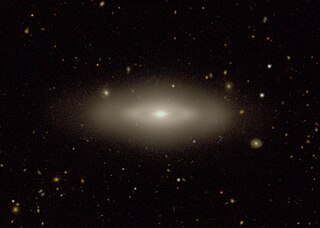
NGC 148 is a lenticular galaxy located in the constellation Sculptor. It is about 40,000 light years across. It is in a group of three galaxies along with MCG-5-2-16 and IC 1555. It is a Shapley-Ames galaxy.

NGC 516 is a lenticular galaxy located in the constellation of Pisces. It was discovered on September 25, 1862 by Heinrich d'Arrest.
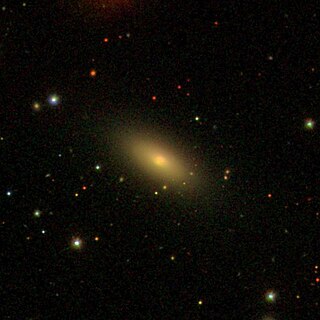
NGC 528 is a lenticular galaxy located in the constellation Andromeda. It is located an estimated 70 million parsecs from the Milky Way. The object was discovered on 22 August 1865 by the German-Danish astronomer Heinrich Ludwig d'Arrest.
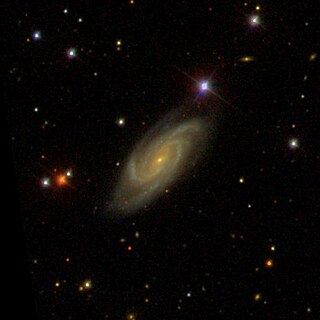
NGC 551 is a spiral galaxy in the constellation Andromeda. It is estimated to be about 205 million light-years from the Milky Way. The object was discovered on 21, September 1786 by the German-British astronomer William Herschel.



















